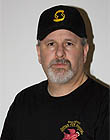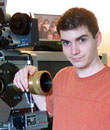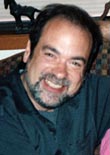|
|
This topic comprises 2 pages: 1 2
|
|
Author
|
Topic: Projectionist Handbook?
|
|
|
|
|
|
|
|
|
|
|
|
|
Frank Angel
Film God

Posts: 5305
From: Brooklyn NY USA
Registered: Dec 1999
|
 posted 09-07-2003 05:55 PM
posted 09-07-2003 05:55 PM





Gerard, we have an identical lens & aperture holder....likewise our goal has always been committed to showing each film as the director and DP intended and I can say, we have never had a union projectionist in our booth...licensed yes; union, no. ![[Wink]](wink.gif)
Tim, welcome aboard. We have a lot in common -- I also work in an old single screen running art-house format in a non-profit situation; and yes, correct aperture and lens combination for the proper aspect ratio on the screen for any given older title can be a bit daunting, especially for flat (non-anamorphic or spherical) films.
Thing is, rummaging through old plates and lenses and trying to figure out what was done over the years is probably not the way to go about it. If you don't feel qualified yet to do it yourself, get a film technician who can use an SMPTE PA35 test film, sometimes called RP40, to see what plates and lens combinations work. You may find that some were never correct or the plates that are needed are missing. If you are lucky, you will find the correctly filed plate for each lens and you may not need to do anything more than label them so you know which is which. But you may also find that things aren't quite right, then the tech may have to file new plates and you may even find that you need new lenses for one or more formats. But before that, let's take a look at what formats you actually need to accomodate in a theatre that runs a wide variety of films from different eras in cinema history.
There basically are five flat aspect ratios that have more or less found enough exceptance that might see these numbers: 1.33, 1.37, 1.66, 1.75 and 1.85. To project these properly, you would need five sets of lenses and five correctly cut aperture plates. Luckily, you can probably get away with eliminating two of them, so only three sets of actual lenses and plates will be needed.
If you don't run silent films, you can scratch the 1.33 silent format, and even if you do, there is a cost-saving trick you can use so you still don't need a separate lens for it. You can also scratch the 1.75 format because it is close enough to 1.66 and it was mostly Disney that officially called their releases 1.75, yet they play fine at 1.66. But how to distinguish between the remaining three? The answer is not always easy and most often what some projectionist wrote on the can or the leaders may NOT accurate. Most classic prints that wind up playing commercial mulitplexes will have 1.85 scrawled on it only because that's the only lens and aperture set that projectionist had or even knew about, so he figures, "if it aint scope, it's flat 1.85". Sometimes even the people in distribution mislabel prints. For example, prints of CINEMA PARADISO were officially called 1.85, when, in fact, only the subtitles were printed so they would play in 1.85 houses, but the film itself needed to play 1.66 -- played in 1.85 and you had to choose between seeing subtitles or a far shot of an actor with his head completely severed by the top edge of the frame; it really had to be projected at 1.66, the European standard. Japan on the other hand seems to have accepted our 1.85 on a lot of their releases -- we have seen a lot of Japanese foreign films hard-matted at 1.85 (America's bad influence).
Prior to 1953, all sound films were shot in the standard Academy frame, or 1.37:1 (sometimes people still call it 1.33 out of habit or something, but they really mean 1.37). That's the easy part. Just put up at the top of your Aspect Ratio Chart in your booth, "1.37 = all sound films pre-1953." But then it gets cloudy.
In 1953 Fox introduced anamorphic wide screen in the form of THE ROBE -- trade name: CinemaScope, shortened to "scope" by projectionists. It produced a screen aspect ratio of 2.55:1. Don't worry about that, because that was quickly changed to 2.35.1 to accommodate an optical soundtrack, but you will rarely if ever encounter a mag-only print, and again, that will not require a new lens, just a new aperture plate. Do you have mag capability? If not, then totally forget about 2.55 because it only is a concern when the print has 4 track mag sound and no optical track.
Today scope is pretty much scope. The 2.35 has recently been morphed to 2.39, and again, this doesn't necessarily require a new lens, only a plate that has been cut to the new slightly smaller dimensions, and possibly some tweaking of the screen masking. But bottom line, that 2.39 plate and lens will work for any non-mag-only scope picture you play, old or new.
Soon after the installation of the super-wide CinemaScope screens, exhibitors, seeing that WIDE was the hottest buzzword in decades, decided that they could no longer show the non-CinemaScope films in that puny, nearly square Academy ratio of 1.37:1 (even though that was the way it was shot). They hit on the poor man's way of making non-anamorphic films WIDER. How? Simply by cropping the top and bottom of the film frame in the projector and using a larger magnification lens to blow that cropped image up so it meets the top and bottom the screen, making it wider in the process, but at the cost of screen brightness and image resolution. At first they did this using mild amounts of croping, like 1.46 (I worked in a theatre that used 1.58). There was no standard and it was all over the map. Mild crops were not terribly destructive to image composition, but then they got bolder and started using more severe crops and insisted that Hollywood shoot films that could be cropped even further. 1.66 became very popular, as did 1.75 as mentioned, by Disney. Finally, in their lust for WIDE, they cropped to 1.85:1 and even 2:1. Hollywood followed, but because none of this was written in stone (I have still not been able to find the exact date that 1.85 appeared as an SMPTE standard), many directors and DPs shot with the 1.66 as their primary target and made sure 1.85 was framed OK and that below 1.66 was clear of mics and set gack. As late as 1967 I still saw reel bands that showed three aspect ratios -- a minimum, a maximum, and mean. The minimum on WHO'S AFRAID OF VIRGINIA WOLF was 1.37 -- filmed right out to the full frame. 1.66 was listed as the mean in the original release, although even the DVD is cropped to 1.85 and IMDB claims 1.85 as does the DVD. So it is in this time frame, between 1953 and say 1967 where it is unlikely that 1.85 is the correct AR. For flat films in that time period, I would go with the less severe 1.66. I have screened many "gray area" flat films in both 1.66 and 1.85 and wound up choosing the former to be the obviously the better looking composition. And, of course, all things being equal, 1.66 gives you more light and better resolution thru less magnification.
So for flat titles your will need lenses and aperture plate for the following formats and your chart will read:
FLAT TITLES
1.33 = Silent films (not soundtrack area)
1.37 = (Academy Ratio) Sound films until about 1953
. Silent films converted to sound film.
1.66 = Foreign films not hard-matted to 1.85.
. American films made between 1953 to about 1967 -- the later the date, the more uncertain. Dispite any present day claims of 1.85, treat films in this perios suspect and pre-screen to see which format looks better. Other than that, no matter if someone has written 1.85 on it, check it at 1.66.
1.75 = Play at 1.66
1.85 = all titles made from about 1969 to present.
SCOPE titles:
2.39:1 All titles from any date, except the early mag-only prints as noted above.
Now what about silents that are in the original silent format with no soundtrack added. Will you need a separate lens for that? Well, the silent film aperture is the fill height of the 35mm film frame; each frame meets the one before it and after it with practically no septum -- conveniently enough, so do the anamorphic frames. Thus, you can use the prime lens from the anamorphic attachment (carefully unscrew the attachment from the prime lens) and there you have your lens for silent format prints. This assumes you don't have a combo anamorphic where the prime lens is part of the anamorphic to make one single lens structure -- you don;t want to try to unscrew that -- ![[uhoh]](graemlins/uhoh.gif)
but combos were not very common in older booths. You will need to cut a silent aperture plate to free up the space normally used to block the soundtrack in sound films, but that's about it. Just a note: cutting aperture plates is tricky for someone who is not familiar with the arduous task of aperture plate filing, so leave it to someone who has done this before and is well versed in how to cut plates using the SMPTE PA35 (RP40) test film; still, it would be wise to buy a few extras plates as small mistakes are easily made and no small mistake in aperture filing is small on the screen.
Down side of using the prime lens from the anamorphic (scope) lens assembly -- you then have to realign the anamorphic so it produces a level horizon after you reattach it. It's do-able, but it's nice to have the additional silent lens so you don't have to do that every time you run a silent format print.
Also, silent films have a whole set of issues that are specific to them beyond just the aperture and lens, like speed control and, for the very early silents, even non-standard aperture dimensions
If you are going to specialize in silent films and silent archive material, then it can get pretty complicated and you need to go into these other issues in depth and with a qualified technician. Also, for original silent materials, your booth and equipment have to be nitrate safe, which they might be in an old theatre, but it adds another dimension to dealing with silent film. And nitrate film should never, EVER be handled by anyone other than trained, professional film technicians. But if you are only showing silents that are available from some specialty distributors like KINO International, then most of them are already reprinted on safety stock and are converted to the 1.37 standard sound format with no need for modification of your lenses or plates.
Please, give us more details of the booth equipment and PICTURES!
Frank
| IP: Logged
|
|
William Hooper
Phenomenal Film Handler
Posts: 1879
From: Mobile, AL USA
Registered: Jun 99
|
 posted 09-08-2003 01:13 AM
posted 09-08-2003 01:13 AM





To add some operational info to Frank's excellent info, but if you've got a movie & no tech:
The Internet Movie Database
www.imdb.com
is correct about 95% of the time as to what aspect ratio a film is in. Look up "Casablanca", click on "Technical Specs", look under "Aspect Ratio", & you will see the movie is in 1.37
When you've found the lenses & aperture plates for say 1.37, label the plate with masking tape "1.37", & label the lens "1.37".
If you have two projectors, you will label the plate for the left projector "1.37 #1" and for the right projector "1.37 #2". Same for the lenses.
Job done for next time you run a 1.37 print.
The lenses & plates for 1.85 will be different, find them, label them. Same for scope & 1.66.
-------------
Good luck on not getting confusing & weird stuff like the Gone Wtih the Wind re-release printed 1.37 anamorphically in the scope frame, or Wizard of Oz printed 1.37 in the 1.85 frame.
----------
Does it take more shipping cans to return the films after you've run them?
| IP: Logged
|
|
|
|
|
|
|
|
|
|
Jannette McQueen
Film Handler
Posts: 50
From: Saskatoon, Saskatchewan, Canada
Registered: Sep 2003
|
 posted 09-12-2003 01:41 AM
posted 09-12-2003 01:41 AM




When I first started in projection my head projectionist let me borrow his BKSTS "Projectionist's Training Manual" which he'd said was a really good book and just in general is a good referance to have. So I read through the first section, which was geared toward my level, and even though a lot of the information in it, I had already come across at one point or another, it puts it into a really good, easy to read format. It has stuff for people just starting off in projection, for the more advanced people and for maintenance of the equiptment and such. It is a really good book. So good in fact, that after I gave it back to him, I had to ask where I might find a copy I could buy, and I eventually got it off the internet at the site that Martin Brooks mentioned BKSTS. It did end up costing me a fair bit, but I think it's a good enough book, and it's worth it, if you're really into this stuff ![[Wink]](wink.gif) And really, it's no more than a textbook you'd buy for school or something. And really, it's no more than a textbook you'd buy for school or something.
Good luck on finding something! :E
| IP: Logged
|
|
|
|
|
|
|
|
All times are Central (GMT -6:00)
|
This topic comprises 2 pages: 1 2
|
Powered by Infopop Corporation
UBB.classicTM
6.3.1.2
The Film-Tech Forums are designed for various members related to the cinema industry to express their opinions, viewpoints and testimonials on various products, services and events based upon speculation, personal knowledge and factual information through use, therefore all views represented here allow no liability upon the publishers of this web site and the owners of said views assume no liability for any ill will resulting from these postings. The posts made here are for educational as well as entertainment purposes and as such anyone viewing this portion of the website must accept these views as statements of the author of that opinion
and agrees to release the authors from any and all liability.
|

 Home
Home
 Products
Products
 Store
Store
 Forum
Forum
 Warehouse
Warehouse
 Contact Us
Contact Us




 Printer-friendly view of this topic
Printer-friendly view of this topic





![[Smile]](smile.gif)





![[Wink]](wink.gif)
![[uhoh]](graemlins/uhoh.gif)

![[beer]](graemlins/beer.gif)





